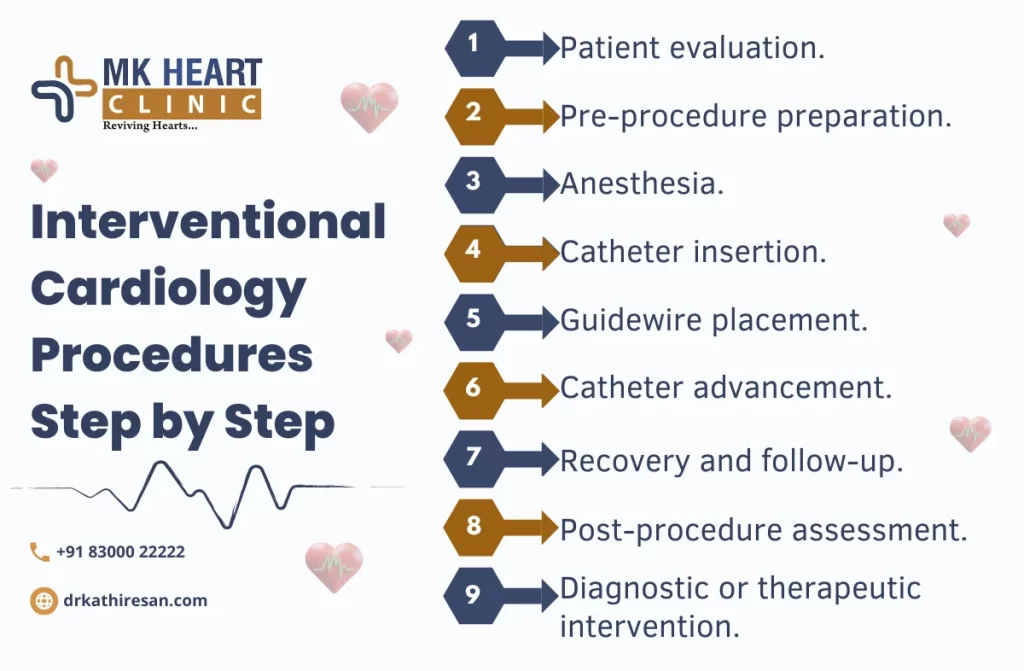Interventional cardiology is focused on utilizing minimally invasive procedures for both diagnosis and treatment of various heart conditions. The interventional cardiology procedures are performed using catheters and other small instruments inserted through blood vessels, eliminating the need for open-heart surgery.
In this guide, we will explore some of the most common procedures of interventional cardiology and their significance in managing cardiovascular diseases.
Coronary Angiography
Coronary angiography is a vital diagnostic procedure used to visualize and evaluate blood flow in the coronary arteries. It is instrumental in diagnosing coronary artery disease (CAD) and determining the precise location and severity of arterial blockages or narrowings. In these interventional cardiology procedures, a catheter is carefully inserted into a blood vessel, typically in the groin or wrist, and guided to the heart.
Contrast dye is then injected through the catheter, enabling detailed X-ray imaging of the coronary arteries. These images aid cardiologists in identifying abnormalities such as plaque buildup or artery narrowing, which can impede blood flow to the heart.

Percutaneous Coronary Intervention (PCI)
Percutaneous coronary intervention, commonly known as coronary angioplasty or stenting, is a minimally invasive procedure used to treat narrowed or blocked coronary arteries. These cardiology interventional procedures are often performed immediately after coronary angiography if significant blockages are detected.
During the procedure, a specialized catheter with a deflated balloon is advanced to the site of the blockage. The balloon is then inflated, compressing the plague against the artery walls and widening the artery. In many cases, a stent, a small mesh tube, is placed at the site of the blockage to help keep the artery open. This improves blood flow and provides long-term support for the artery.
Transcatheter Aortic Valve Replacement (TAVR)
Transcatheter aortic valve replacement is a breakthrough procedure used to treat severe aortic valve stenosis, a condition where the aortic valve becomes narrowed and restricts blood flow from the heart to the rest of the body. Traditionally, aortic valve replacement required open-heart surgery. However, TAVR offers a less invasive alternative, particularly for patients who are considered high-risk or inoperable for open-heart surgery.
During these interventional cardiology procedures, a catheter is inserted into a blood vessel, usually in the groin or chest, and guided to the heart. A collapsible artificial valve is then delivered through the catheter to the site of the diseased aortic valve. The new valve is expanded by pushing aside the old valve besides taking over its function, and also restores proper blood flow.
Balloon Valvuloplasty
Balloon valvuloplasty is a therapeutic procedure used to treat narrowed heart valves, such as the mitral valve or the pulmonary valve. It is often considered a temporary measure to relieve symptoms and improve heart function, particularly in cases where open-heart surgery is not immediately necessary or feasible.
During the cardiology interventional procedures, a catheter with a deflated balloon at its tip is inserted into the narrowed valve. The balloon is then inflated, stretching and widening the valve, improving blood flow. It provides immediate relief by temporarily improving valve function and reducing symptoms such as shortness of breath and fatigue.
Ablation Procedures
Ablation procedures treat certain types of abnormal heart rhythms, such as supraventricular tachycardia or atrial fibrillation. These abnormal rhythms, also known as arrhythmias, can significantly impact a person’s quality of life and increase the risk of complications such as stroke or heart failure. These interventional cardiology procedures aim to restore a normal heart rhythm by selectively destroying the abnormal tissue responsible for the irregular electrical signals.
During the procedure, catheters with electrodes are inserted into the heart and positioned in the areas causing the arrhythmia. Different energy sources, such as radiofrequency or cryotherapy, are then applied to destroy the targeted tissue and interrupt the abnormal electrical pathways.
Closure of Congenital Heart Defects
Interventional cardiology also plays a crucial role in the closure of certain congenital heart defects. Some of these congenital heart defects, such as atrial septal defects (ASDs) and patent ductus arteriosus (PDA), can be successfully treated using minimally invasive procedures.
These interventional cardiology procedures eliminate the need for open-heart surgery, leading to faster recovery times and reduced risks. Using catheters and specialized devices, such as septal occluders or coil occluders, the defects can be closed. These devices are guided to the site of the defect, where they are positioned and deployed to block abnormal blood flow.
Conclusion
To conclude, interventional cardiology procedures have revolutionized the management of various cardiovascular conditions, providing less invasive alternatives to traditional open-heart surgery and have significantly improved patient outcomes, reduced hospital stays, and enhanced overall quality of life. As technology continues to advance, interventional cardiology will likely evolve further, offering even more innovative and effective treatments for heart disease.


